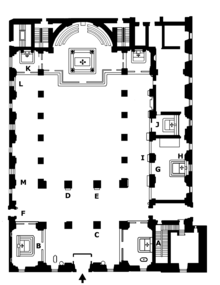
Back Базилика (титул) Bulgarian Basilika (Titel) German Basilique (christianisme) French Basilika dalam Gereja Katolik ID Basilica (cattolicesimo) Italian Базилика (титул) Russian Bazilika Slovenian Basilika (kyrkorätt) Swedish มหาวิหารคาทอลิก Thai Mga basilika sa Simbahang Katolika Tagalog

Basilicas are Catholic church buildings that have a designation, conferring special privileges, given by the Pope. Basilicas are distinguished for ceremonial purposes from other churches. The building need not be a basilica in the architectural sense (a rectangular building with a central nave flanked by two or more longitudinal aisles). Basilicas are either major basilicas, of which there are four, all in the Diocese of Rome, or minor basilicas, of which there were 1,810 worldwide as of 2019[update].[1]
Numerous basilicas are notable shrines, often even receiving significant pilgrimages, especially among the many that were built above a confessio or the burial place of a martyr; although this term now usually designates a space before the high altar that is sunk lower than the main floor level (as in the case in St Peter's and St John Lateran in Rome) and that offer more immediate access to the burial places below. Some Catholic basilicas are Catholic pilgrimage sites, receiving tens of millions of visitors per year.[2][3]
Churches designated as papal basilicas, in particular, possess a papal throne and a papal high altar, at which no one may celebrate Mass without the pope's permission.[4]
- ^ "Basilicas in the World". GCatholic.org. 2019. Retrieved 12 December 2019.
- ^ Sacred Travels by Lester Meera 2011 ISBN 1-4405-2489-0 page 53
- ^ "Eternal Word Television Network, Global Catholic Network". Ewtn.com. 13 June 1999. Retrieved 17 February 2012.
- ^ Gietmann, G. & Thurston, Herbert (1913). . In Herbermann, Charles (ed.). Catholic Encyclopedia. New York: Robert Appleton Company.
© MMXXIII Rich X Search. We shall prevail. All rights reserved. Rich X Search